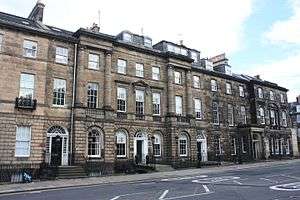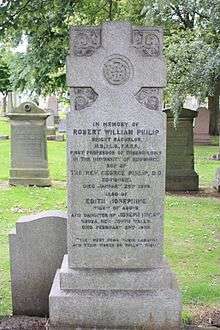Robert William Philip
| Robert William Philip | |
|---|---|
| Born |
29 December 1857 Govan, Renfrewshire |
| Died |
25 January 1939 (aged 81) Edinburgh |
| Nationality | British |
| Occupation | Extra-Physician to H.M. the King in Scotland; Consulting Physician, Royal Infirmary, Edinburgh; Professor of Tuberculosis, Edinburgh University |
| Years active | 1887 - 1939 |
| Known for | Tuberculosis |
| Relatives |
|


Sir Robert William Philip Kt MD LLD FRCPE FRCP FRSE FRCSE[1][2] (29 December 1857 – 25 January 1939) was a pioneer in the treatment and control of tuberculosis.
Life
He was the son of Rev George Philip DD, minister of the Union Church in Govan, and his wife, Margaret Josephine Robertson.[3]
He was educated at the Royal High School in Edinburgh and the University of Edinburgh, graduating MB CM in 1882 and receiving his doctorate (MD) in 1887. In 1889 he was elected a Fellow of the Royal Society of Edinburgh. His proposers were Sir Thomas Grainger Stewart, Sir William Turner, Robert Flint and David James Hamilton. He served as the Society's Vice President from 1927 to 1930.
He married Elizabeth Motherwell[1] in 1888, and Edith McGaw in 1938.[1] For much of his life, he lived at 45 Charlotte Square,[4] one of Edinburgh's most exclusive addresses.
During World War I, he held the rank of Lieutenant-Colonel, Scottish Second General Hospital in the Royal Army Medical Corps.[5][6]
He died in 1939 and is buried in Grange cemetery in Edinburgh.[7] The grave lies on the main eastern path, not far from the entrance. His wife Edith Josephine McCaw lies with him.
Work on Tuberculosis
Robert William Philip qualified to practise in 1882, the same year that Robert Koch discovered the tuberculosis bacillus. The focus of his work over the coming years was the implementation of his vision for coordinated treatment of tuberculosis. He founded the first tuberculosis dispensary clinic in Edinburgh at 13 Bank Street[8] on the 25th November 1887.
In 1894 he founded the Victoria Hospital for Consumption at Craigleith House in Craigleith Road, Edinburgh as a sanitorium, designed to work in conjunction with the dispensary clinic. Prior to the discovery of medication to treat tuberculosis, his focus was to isolate patients from family and friends and offer sun, fresh air and exercise.[8]
By 1912 the integrated approach to TB treatment was recognised and adopted by government and the first similar clinic in England opened at Paddington.
He took a chair in tuberculosis at Edinburgh University in 1917.[1] He was president of the Royal College of Physicians of Edinburgh from 1918 to 1922.[9] In 1927 he was president of the British Medical Association.[9]
Honours and awards
He was elected a Fellow of the Royal Society of Edinburgh in 1889.[10] He was knighted in the 1913 New Year's Honours list.[11][12]
In 1955 his work was recognised on a Belgium Stamp[13]
In 1966, Royal Victoria Hospital TB Trust gifted £3,000 to the Royal College of Physicians to provide a lectureship as a memorial to Sir Robert Philip for the advancement of medical and surgical science with reference to TB and allied diseases, the prevention of these diseases and the care and treatment of people suffering from them.
References
- 1 2 3 4 Royal College of Physicians Obituary
- ↑ Whitaker's Peerage, Baronetage, Knightage and Companionage 1921
- ↑ BIOGRAPHICAL INDEX OF FORMER FELLOWS OF THE ROYAL SOCIETY OF EDINBURGH 1783 – 2002 (PDF). The Royal Society of Edinburgh. July 2006. ISBN 0 902 198 84 X.
- ↑ Commemorative stone plaque at 45 Charlotte Square, Edinburgh
- ↑ Glasgow Herald Obituary
- ↑ Scottish Second General Hospital Information
- ↑ Family Search record of grave
- 1 2 History of Craigleith House
- 1 2 Royal College of Physicians, Edinburgh Obituary
- ↑ "Fellows of the Royal Society in Edinburgh" (PDF). Royal Society of Edinburgh. p. 245.
- ↑ "The New Year Honours." Times London, England 1 Jan. 1913: 7+. The Times Digital Archive. Web. 5 Feb. 2016.
- ↑ BIOGRAPHICAL INDEX OF FORMER FELLOWS OF THE ROYAL SOCIETY OF EDINBURGH 1783 – 2002 (PDF). The Royal Society of Edinburgh. July 2006. ISBN 0 902 198 84 X.
- ↑ Belgium Stamp from 1955
External links
- Painting at the Royal College of Physicians
- Article in The Scotsman
- British Medical Journal Obituary
- Royal College of Physicians Obituary
- Commemorative Blue Plaque on Bank St., Edinburgh
- Commemorative stone Plaque at 45 Charlotte Square, Edinburgh
- Glasgow Herald article commemorating 50th Anniversary of clinic on Bank Street
- Glasgow Herald article pointing towards ultimate elimination of tuberculosis including message from the King
- Glasgow Herald report on funeral
| Academic offices | ||
|---|---|---|
| Preceded by William Russell |
President of the Royal College of Physicians of Edinburgh 1918–1923 |
Succeeded by George Lovell Gulland |